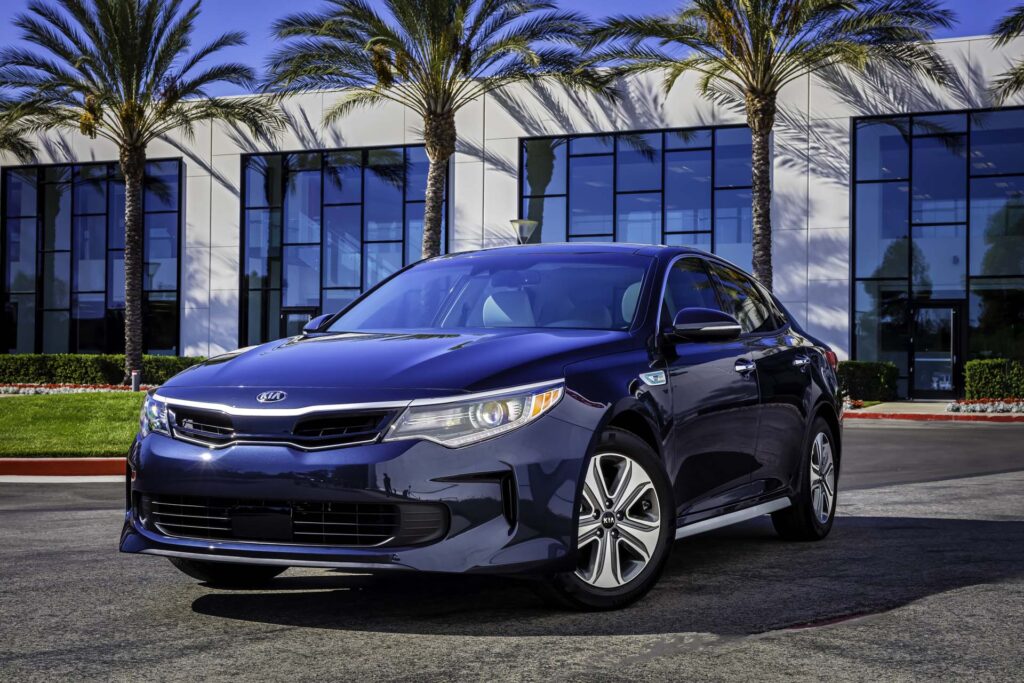
The 2018 Kia Optima’s chief appeal will be its ride quality and competent handling—as it should be for a mid-size sedan.
Balance, neutral ride and crisp turn-in help it earn one point above average, and the rest of the tale of the tape for the Optima keep it mid-pack with its competitors. It earns a 6 out of 10 for its trio of inline-4s, some of which are turbocharged, and middle-of-the-road transmissions. (Read more about how we rate cars.)
Let’s talk numbers. Base Optima LX, Optima EX, and Optima S sedans and will be fitted with a 185-horsepower, 2.4-liter inline-4 that uses direct injection to maximize fuel economy. That’s fitted to a 6-speed automatic that needs convincing to bring the busy 2.4-liter inline-4 into its sweet-spot for passing power. Its peak torque output happens at 4,000 rpm, which is lower than the top turbocharged offerings, so kicking down a couple gears to pass is the name of the game on steep mountain inclines. We’ve found in our drives that the base 2.4-liter inline-4 is smooth and should be adequate for most buyers’ needs, provided that need isn’t outright speed.
An optional 1.6-liter turbo-4 is found in LX models that makes 178 hp and 195 lb-ft of torque and is mated to a 7-speed dual-clutch automatic. Its trick is efficiency, although it’s hardly a pokey engine. It feels more responsive than the 2.4-liter inline-4, but we’ve found that it’s somewhat hamstrung by a indecisive 7-speed dual-clutch that clobbers through gears compared to similar units made by Volkswagen or Ford. The 1.6-liter turbo-4 is how the Optima manages combined fuel economy over 30 mpg, although every model is fuel-efficient for its class.
The 2.0-liter turbo-4 found in SX models are the most fun to drive. Mated to a 6-speed automatic, the 2.0-liter turbo-4 makes 245 hp and 260 lb-ft and comes on strong lower in the rev range (just 1,350 rpm). The top-end engine reads your right foot well; downshifts come quickly and paddle-shifters give drivers granular control over what gear to use and when to use it. More sound-deadening in SX models quells the 2.0-liter’s harsher vibrations, which we appreciate.
Optima ride and handling
The 2018 Kia Optima is a smooth mover with revised suspension bits from previous generations. The Optima retains a familiar MacPherson front strut and multi-link rear setup, although revised front bushings and cushier springs damps fussy pavement.
The trade-off is a little more body lean, which isn’t uncouth for its class. The Optima irons out the road in return for a tippier cornering character—we think flat and fast will be the upcoming Stinger’s purview anyway.
All models come with selectable drive modes that toggle the throttle response and transmission behavior among Eco, Normal, and Sport modes. We’ve found the Normal mode to be the goldilocks zone for most circumstances; Sport can be too hot, Eco can be too cold.
This year, all trims of the Optima adopt a steering system that we prefer over an older setup, thanks to its sharper feel when the roads get curvy.



